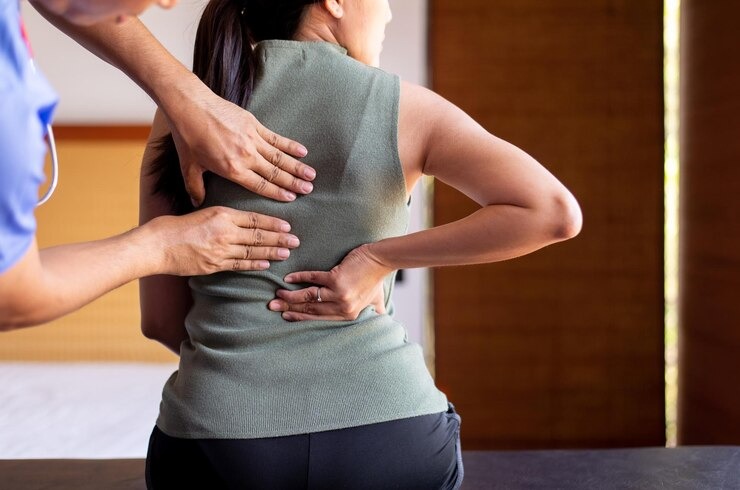Back pain is a common condition that Ayurveda treats, and knowing the dosha influence on this ailment can provide valuable insights into effective Ayurvedic treatments. In the ancient science of Ayurveda, the balance of three fundamental energies, or doshas – Vata, Pitta, and Kapha – plays a crucial role in maintaining overall health and well-being. These doshas govern various physiological and psychological functions in the body, and any imbalance among them can lead to a range of health issues.
Causes of Back Pain
- Muscle or Ligament Strain
Cause: Overstretching or tearing of muscles and ligaments, generally due to rapid movements or poor lifting techniques.
Risk Factors: Poor posture, lack of exercise, and poor muscle strength.
- Disc Problems
Cause: Herniated or bulging discs can put pressure on nerves, leading to back pain.
Risk Factors: Aging, genetic predisposition, and improper lifting.
- Spinal Stenosis
Cause: Back discomfort may result from compressed nerves caused by herniated or bulging discs.
Risk factors: Include inappropriate lifting, aging, and genetic predisposition.
- Osteoarthritis
Cause: Degeneration of the cartilage between the vertebrae.
Risk factors: Include joint usage, aging, and family history.
- Scoliosis
Cause: An abnormally curved spine
Risk factors: Include fast growth during adolescence, genetics, and congenital conditions.
- Osteoporosis
Cause: The bones get weaker and are more prone to breaking.
Risk factors: Include malnourishment, hormonal fluctuations, and aging.
- Poor Posture
Cause: Extended periods of ill-posed sitting or standing.
Risk factors: Include desk work and a sedentary lifestyle.
- Trauma or Injury
Causes: include mishaps, falls, and injuries sustained in sports.
Risk factors: include engaging in high-impact sports or working in jobs where accidents are more likely.
- Infections and Tumors
Rarely, tumours or infections in the spine might be the cause of back discomfort.
Immunocompromised Illnesses and specific malignancies are risk factors.
Symptoms of Back Pain:
- Localized Pain
Aching, stabbing, or uncomfortable feelings in a particular back region
- Radiating Pain
Pain that extends from the back into the buttocks, legs, or even foot.
- Muscle Stiffness
Difficulty in moving or bending due to tightness in the muscles.
- Limited Range of Motion
Having muscular tightness that makes it difficult to move or bend
- Numbness or Tingling
Feelings of weakness, tingling, or numbness in the limbs or back.
- Pain worsened by Certain Activities
Discomfort that intensifies with specific movements or activities.
- Chronic Pain
Persistent pain persists for longer than three months.
- Pain Aggravated by Stress
Stress on an emotional level is causing more back discomfort.
- Pain Accompanied by Other Symptoms
Extra symptoms such as fever, inexplicable weight loss, or problems with the bladder or bowel could point to a more serious underlying illness.
It’s important to remember that there are many possible causes of back pain and that a thorough evaluation from a medical professional is key to receiving an accurate diagnosis and the right course of treatment. Medications, physical therapy, lifestyle changes, and in certain situations, surgery, are among possible treatment modalities. Doshas’s Part in Back Pain:
Vata Dosha and Back Pain
Movement within the body is attributed to vata, which is connected to the elements of ether and air. Back pain, dryness, and stiffness might result from an overabundance of Vata in the spine. People who are mainly Vata in nature, or who have an imbalance of Vata, may be more susceptible to lower back pain and discomfort.
Ayurvedic Treatment for Vata-related Back Pain
- Vata can be calmed by warm oil massages (Abhyanga) using mustard or sesame oil.
- Easy workouts to increase flexibility without exerting too much energy
Pitta Dosha and Back Pain
Pitta is related to heat and metabolism and is ruled by the elements of fire and water. Intense back pain and inflammation may be caused by an overactive Pitta in the body. Pitta-constitution holders or those experiencing a Pitta imbalance may feel a scorching, stabbing pain in the lower back.
Ayurvedic Treatment for Pitta-related Back Pain
- Cool compresses or topical application of cooling oils like coconut oil.
- A diet rich in cooling foods that are soothing to the pitta.
Kapha Dosha and Back Pain
The elements of earth and water have an impact on kapha, which is responsible for the body’s structure and lubrication. Stiffness, heaviness, and dull discomfort can be caused by an overabundance of Kapha in the spine. People with a Kapha constitution or a Kapha imbalance may be more prone to persistent, long-lasting back discomfort.
Ayurvedic Treatment for Kapha-related Back Pain
- Frequent exercise to improve circulation and lessen stagnation
- Herbs that are warm and energising for the diet and formulations that balance Kapha
Ayurvedic Treatment for Back Pain in India
Back pain treatment in India, the home of Ayurveda, provides many conventional Ayurvedic back pain treatments. In India, Ayurvedic doctors frequently recommend customized regimens of herbal medicines, dietary changes, and lifestyle adjustments to address the individual dosha imbalances that contribute to back pain.
In the field of Ayurveda, understanding how doshas effect back pain is essential to creating successful treatment plans. Ayurvedic treatment for lower back pain can be customized to address dosha imbalances and individual constitutions to promote long-term back pain alleviation and holistic healing. Embracing the ancient wisdom of Ayurveda not only alleviates symptoms but also improves total well-being, ensuring a balanced and harmonious life.

